
Which Country is the World’s Biggest Beer Producer? (You Might Be Surprised)
Beer is one of the oldest alcoholic drinks in the world and the most widely consumed. It’s thought to be the third most popular drink overall, after water and tea. It’s a huge worldwide industry. But which country produces the most beer?
In the latest BarthHaas Report, the biggest producers of beer in the world were found by looking at how many hectolitres of beer each country produces. Below, we examine these beer manufacturers, looking at their history with beer and consumption habits.
If you’ll be travelling to one of these countries to enjoy their local beer, make sure you’re covered with our international travel insurance. Want to travel to all of these countries? Get handy annual travel insurance to cover you for multiple trips.
China
China is the largest producer of beer in the world, with an output of 360 million hl. China has a long history of beer production, dating back around nine thousand years. It was used in rituals such as ancestral worship and funerals. During the Han dynasty, beer fell out of favour and was replaced by huangjiu. This trend continued for around two thousand years.
By the end of the 19th century, beer brewing began to rise in prominence again, with the arrival of Polish, German, and Czechoslovakian people who set up breweries. Now, there are a large number of breweries across China that mainly serve the local region.
China has the largest national consumption of beer per year, with 43 million litres consumed. However, when looking at consumption per capital, China comes in 46th out of 62 of the countries included. Its per capita beer consumption currently stands at around 27.94, down from the peak in 2014 of 32.29. It’s due to steadily rise over the next few years to 28.56, and non-alcoholic beer is also growing in popularity.
USA
The USA is the second largest producer of beer in the world. It has an output of 194 million hl, which includes hard seltzers and flavoured malt beverages. The US’s history of beer brewing dates back to the 16th century. The first commercial brewery was opened in 1632 and followed the brewing traditions of England and the Netherlands.
Prohibition in the early 20th century caused many breweries to close down or produce non-alcoholic beverages. After prohibition, many of the big breweries returned to beer production, and it’s these same breweries that retain their dominance on the market. Even so, there has been a growing number of smaller breweries and craft beer breweries that have been established in the past few decades.
Beer is the most popular alcoholic beverage in the US, with sales taking up 54% of the market share. The US consumes the second-largest amount of beer per year in the world, at 23,920.
Brazil
Brazil is the third-largest producer of beer in the world, with an output of 147 million hl. Brazil’s history of beer brewing dates back to the early 19th century which saw large numbers of German immigration to the country.
Brazil’s per capita consumption of beer has declined in recent years, from 67 litres in 2012 to around 58 litres in recent years. The market in Brazil is dominated by one brewer – AmBev, part of InBev, the world’s largest brewer. It takes 70% of the market share. The next largest brewer, Grupo Schincariol, takes 11.6% of the market. Recently, there have been a number of microbreweries producing craft beer that have emerged.
Brazil has the third-highest national consumption of beer per year, at 12,401 litres. During carnival, beer consumption sees a major increase. It’s estimated that 400 million litres (around 4% of the annual production) is consumed over the four-day period.
Mexico
Mexico is the fourth-largest maker of beer in the world, producing 141 million hl per year. While ancient Mesoamerican cultures produced a corn beer, the European tradition of beer brewing was brought to Mexico with the Spanish invasion of the 16th century. The Spanish implemented a number of restrictions on brewing which were removed after the Mexican War of Independence. Then, brewing was allowed to develop freely.
In the early 20th century, there were 36 breweries in Mexico. These have now consolidated into two corporations – Grupo Mondelo and Cervecería Cuauhtémoc Moctezuma – which control 90% of the Mexican beer market. There are also some microbreweries, but these are not as popular as in some other countries, such as the US.
Mexico has the fourth largest national consumption of beer in the world at 12,401 litres per year. Mexico also exports its beer to over 150 countries, including the US, where Corona in particular is popular.
Germany
Germany is the fifth-largest producer of beer in the world and the largest beer manufacturer in Europe, making over 87 million hl per year. Beer has long been a part of German culture, going back centuries.
German beer follows Reinheitsgebot, a series of regulations that limit the ingredients that can be included in beer. The best known version of this law is the Bavarian law of 1516, but modern regulations have been developed since then.
Germany has the fourth-highest consumption of beer per capita and the sixth-highest national consumption. There are a number of beer festivals held in Germany annually, including Oktoberfest which is perhaps the most well-known. Held over 16 to 18 days from late September to October in Munich, only beer brewed within city limits is allowed to be served. Around 7 million litres are served throughout the festival.
